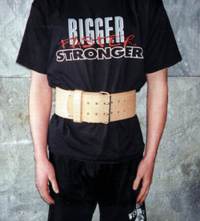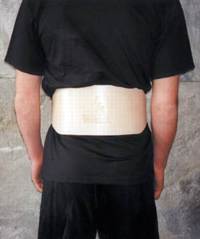BELT ME (Lifting Belts)Coaches should have all three of these basic belts in a weight room. Power Lifting Belts at the squat stations. Lifting or 4-inch Belts at the Clean-Hex Bar/Dead Lift stations. Training or 6-inch BBy BFS Published: Fall 2000 THE POWER BELT The Power Lifting or Power Belt is a double notched 4” belt used in the sport of power lifting. This belt is the same width all the way around. Many power belts on the market are twice the thickness of a noncompetitive leather belt. This belt should be used by athletes when they squat because of its frontal support in keeping the body upright and “sitting tall”. For use in competition. Remember, use a Power Belt for new personal bests. THE LIFTING BELT This belt is the same size as the power belt but tapers around the front of the body in the buckle area. It may not be as thick or as heavy as the power belt. This belt is most effective for training and competing in the Olympic lifts such as the Clean, the Power Clean, the Snatch and the Power Snatch. It enables the lifter to bend down without having the belt dig into his or her stomach and provides sufficient support during the action of the lifts. This belt can also be used most effectively in the Deadlift. It is tapered in the front to allow for a full bend over. Throwers also use this belt in the events of the hammer, discus and the shot because of its support and allowance of flexibility to the athlete. THE TRAINING BELT The use of a 6” non-competitive belt, which is 6” wide in the back and tapers down to 2” in the front is a commonly used belt among athletes, lifters and hobbyist. Why? Many feel the six-inch belt is best and gives extra support for the lower back. This belt cannot be used for a sanctioned Power or Olympic lifting meet. It is for personal training only, and if you really like the feel of it, it’s a great way to train. |
 |
|
THE POWER BELT |
 |
|
THE LIFTING BELT |
 |
|
THE TRAINING BELT |